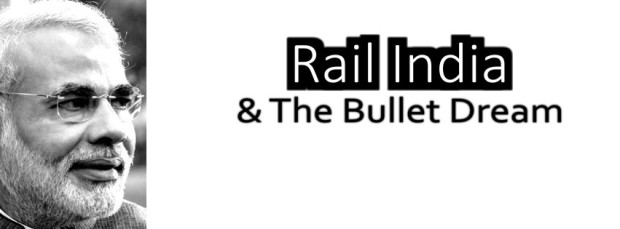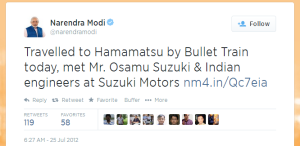 PM Narendra Modi tweeted on 25th July 2012 perhaps confirming about his first bullet train travel.
PM Narendra Modi tweeted on 25th July 2012 perhaps confirming about his first bullet train travel.  It was only in Sep. 2013 that he was officially announced as BJP’s PM candidate. Among several agendas that the historic 2014 elections were contested on, his rallies and speeches covered that India should have high speed trains. In Jan. 2014, he said that he wanted bullet trains to connect India’s 4 major metros by India’s 75th Independence Day (in 2022), calling for new “railway universities” to be opened as centres for engineering innovation in the process. It is encouraging to learn that as soon as he won the elections, his team was working towards his vision and the PM wishes to have the first high-speed train between Ahmedabad and Mumbai running by end-2017 (covering 543 kms at Rs 70000 crores). Many of us believe that his vision is achievable, thanks to the PM’s own implementation ability, work attitude and more so because of his strength in selecting / appointing the right people for the job. His intent in responsible delegation and accountability is noteworthy through the Gujarat model of development.
It was only in Sep. 2013 that he was officially announced as BJP’s PM candidate. Among several agendas that the historic 2014 elections were contested on, his rallies and speeches covered that India should have high speed trains. In Jan. 2014, he said that he wanted bullet trains to connect India’s 4 major metros by India’s 75th Independence Day (in 2022), calling for new “railway universities” to be opened as centres for engineering innovation in the process. It is encouraging to learn that as soon as he won the elections, his team was working towards his vision and the PM wishes to have the first high-speed train between Ahmedabad and Mumbai running by end-2017 (covering 543 kms at Rs 70000 crores). Many of us believe that his vision is achievable, thanks to the PM’s own implementation ability, work attitude and more so because of his strength in selecting / appointing the right people for the job. His intent in responsible delegation and accountability is noteworthy through the Gujarat model of development.
For us, the commoners, the dummy guide says the following about ambitious transport projects in independent India:
Bandra-Worli Sea Link: Idea was conceived in 1990. First stone laid in 1999. Construction began in 2000. The project really took off in 2004. There were hurdles and never ending ones. The project cost jumped from Rs 660 crore to Rs 1360 crore and then to Rs 1650 crore. The route was opened to travel on 30th Jun. 2009. All 8 lanes were opened on 24th March 2010. Operational length: 5.6 kms. Mumbai Monorail: Idea was conceived in 2005, while the decision to introduce monorail as a feeder service to the mass rapid transit system (MRTS) was taken in Sep. 2008. Construction began in 2009. First line began on 2nd Feb. 2014. Operational length: less than 10 kms.
One of these mono-rail lines is right across my house. I have seen no work happening for months together. Complete disruption of road is first undertaken. One then waits for several months before the work could begin or years for work to end. Planning?
Mumbai Metro: First phase inaugurated in Jun. 2006. Construction begins in Feb. 2008. First line started operating on 8th Jun. 2014. To be built in 3 phases, at Rs 19525 crore, 2010’s revised estimates show a cost of Rs 36000 crore (round figure?). Operational length: 11.4 kms.
Mumbai Metro would not have been inaugurated this time round too because of the last minute ticket fare issues
Delhi Metro: Construction started in 1998. First section opened for use in 2002 then covering 8.3 kms. It was the Atal Bihari Vajpayee government perhaps because of which it happened, the work continued, and Delhi has one of the best metro rail in the world. The vision, the start and overcoming all the snarls at a rapid pace is the key we reckon.
Bullet Trains in Japan and China–Asia in perspective:
Japan: Japan’s first high-speed railway line was operational in 1964, a country that was bombed in Aug. 1945 ending the WWII. The first Tōkaidō Shinkansen (bullet train line) stretched 515.4 kms. Japan now operates 2387.7 kms of high-speed rail line. China: High-speed rail service in China was operational in Apr. 2007. The first bullet train covered 1318 kms from Beijing to Shanghai commencing operation in Jun. 2011. Construction began in Apr. 2008. 1140 kms is elevated. There are 244 bridges along the line and the Danyang-Kunshan Grand Bridge, the longest bridge in the world, is 114 kms. Construction of the bridge began in 2006 and the bridge was ready in 2010. By 2020, China is hoping to have 50000 kms of high-speed rail. India: This analytic may sound absolutely vague given the magnitude of the above and future projects, and difference in the involvement of all resources, but considering Mumbai will have a bullet train and the 3 transportation upgrades the city fortunately was emphatic about, it took over 25 years combined to develop 27 kms of operational route. The interest amount alone on the cost of delays would have paid for one or more of these developments. PM Narendra Modi wants the first bullet train to start running in end-2017. The faith is there. We want to see the bullet trains running. Unarguably, not only will it be a treat to the country’s image, but it will also bring enormous economic and travel benefits to commoners of some of the most densely populated areas. We want the luxury, but do not want to call it as one. In stead, it has to become a part of our daily lives. We are delighted that you are wanting the Indian Railways to become world class. We are waiting for the delivery of a great experience. We are believing. Incredible talent is available in India. Resources are in abundance and population age is a big advantage compared to most countries in the world (over a billion people are under 25). Talented work force remains to be created alongside, education here being an obsession anyway.
The key will be in the decision-making through: efficiency, planning, engineering design, accountability from people responsible and companies involved–performance, ability to overcome any impending hurdles, timely delivery.
![]() Follow me on Twitter
Follow me on Twitter
Sources: Wikipedia was the best resource | Other sources: Travel China Guide, Deal Nelson’s Article in The Telegraph,